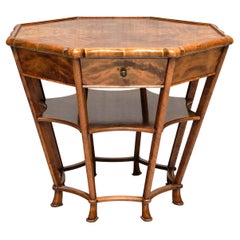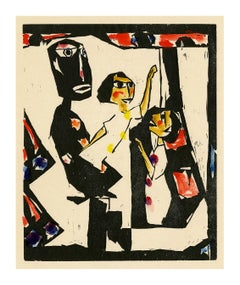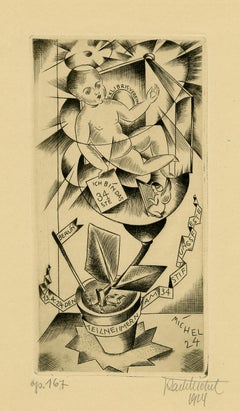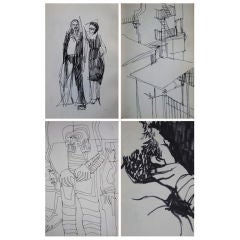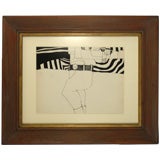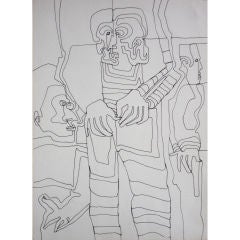German Expressionist 1920s
to
6
1
7
4
4
1
1
2
Sort By
Exceptional Expressionist Octagonal Center Table in Flamed Birch, Germany, 1920s
Located in The Hague, NL
This rare center table was produced in Germany in the late 1920s. Although the maker and designer
Category
Vintage 1920s German Art Deco Center Tables
Materials
Wood, Birch
$11,323
H 25.99 in Dm 33.67 in
'Theater' — 1920s German Expressionism
Located in Myrtle Beach, SC
A German Expressionist woodcut, with original hand-coloring in watercolor, depicting a parent and
Category
1920s Expressionist Figurative Prints
Materials
Woodcut
'Ex Libris Verein' — 1920s German Expressionism
By Karl Michel
Located in Myrtle Beach, SC
designer and expressionist printmaker during Germany's pre-Nazi Weimar Republic (1919-1933). Michel’s work
Category
1920s Expressionist Figurative Prints
Materials
Etching
Collection of 1950-1960s NYC Ink Drawings- Individually Priced
By Richard Karwoski
Located in San Francisco, CA
Expressionist Movement of the 1920's and 30's. "Contemporary man is beset by hang-ups, and this is the statement
Category
Vintage 1950s Drawings
Materials
Ink, Paper, Pen
'Dr. Walter Vogel - Exlibris' — 1920s German Expressionism
By Karl Michel
Located in Myrtle Beach, SC
Michel (1889-1984) was a noted graphic designer and expressionist printmaker during Germany's pre-Nazi
Category
1920s Expressionist Figurative Prints
Materials
Woodcut
$300
H 7.07 in W 4.19 in D 0.01 in
Richard Karwoski Ink Drawing
Located in San Francisco, CA
relationships, inspired by the German Expressionist Movement of the 1920's and 30's. "Contemporary man is beset
Category
20th Century American Paintings
Materials
Ink, Paper
Richard Karwoski Greenwich Village Figurative Drawing
Located in San Francisco, CA
human form and relationships, inspired by the German Expressionist Movement of the 1920's and 30's
Category
20th Century Drawings
Get Updated with New Arrivals
Save "German Expressionist 1920s", and we’ll notify you when there are new listings in this category.
German Expressionist 1920s For Sale on 1stDibs
Find a variety of German expressionist 1920s available on 1stDibs. The range of distinct German expressionist 1920s — often made from wood, metal and oak — can elevate any home. German expressionist 1920s have long been popular, with older editions for sale from the 20th Century and newer versions made as recently as the 20th Century. German expressionist 1920s are generally popular furniture pieces, but Art Deco style is often sought at 1stDibs. Many German expressionist 1920s are appealing in their simplicity, but Erich Heckel, Josef Eberz and Roland Paris produced popular German expressionist 1920s that are worth a look.
How Much are German Expressionist 1920s?
The average selling price for at 1stDibs is $2,300, while they’re typically $850 on the low end and $16,000 highest priced.
Questions About German Expressionist 1920s
- What do I wear to a 1920s party?1 Answer1stDibs ExpertMarch 3, 2023To a 1920s party, you can wear a short fringed or beaded flapper dress, layers of long beaded or pearl necklaces, elbow-length gloves and a feathered headband. Another option is to wear an off-white men's suit. Shop a selection of vintage apparel on 1stDibs.
- 1stDibs ExpertMarch 22, 2022In the 1920s, flappers often wore straight, fitted dresses with plunging necklines and knee-length hems. Fringe was a common embellishment used at the time. Flappers also sported pumps and opted for bras and lingerie instead of corsets for undergarments. Shop a variety of vintage clothing on 1stDibs.
- 1stDibs ExpertJune 15, 2023In the 1920s, fashionable colors included jewel tones. Fashion, jewelry, furniture and decorative objects often featured jade green, deep reds, amethyst purple, dusty mustard yellow and peacock blue. Find a range of 1920s-era jewelry and fashion on 1stDibs.
- 1stDibs ExpertMay 5, 2023In the 1920s, brides often wore tubular-shaped slip dresses with a beaded tunic over top. Hemlines usually fell just below the knee or to the ankle, and many gowns had dropped waists. For headwear, brides often showed off veils attached to cloche or flapper-style headbands. On 1stDibs, shop a collection of wedding dresses from some of the world’s top boutiques.
- What era is 1920s jewelry?1 Answer1stDibs ExpertDecember 4, 2023What era 1920s jewelry is depends on its design. Most people associate this decade with the Art Deco movement, which took inspiration from eclectic sources like Cubism, ancient Egypt and Native American, African and Asian motifs. However, some pieces produced during the 1920s are more in line with the style trends of earlier periods, such as Art Nouveau, Edwardian and Victorian. Explore a diverse assortment of 1920s jewelry on 1stDibs.
- 1stDibs ExpertApril 5, 2024The clothing style in the 1920s that most people think of first is the flapper style. Women who dressed in this style sported loose-fitting, short dresses, often outfitted with drop waists and fringe. Small cloche hats and headbands were signature accessories of the flapper look. During the decade, pleated tennis skirts and cardigan sweater sets left the courts and became staples of some women's everyday styles. For men, soft collars replaced stiff, starched ones, and simple single and double-button suit jackets worn without waistcoats became trendy. Trousers also took on a new shape with wider-cut legs, and Oxford bags gained popularity. On 1stDibs, shop a variety of 1920s apparel and accessories.
- What are 1920s dresses called?1 Answer1stDibs ExpertFebruary 13, 2023The iconic dresses from the 1920s are called flapper dresses. This name comes from the term flapper, which was used to describe young women during the period who enjoyed personal fulfillment and independence in American cities, particularly as they gained the right to vote and enjoy other freedoms previously reserved for men. Flappers danced at jazz clubs and upended most societal restrictions placed on women at the time, and fashion statements typically attributed to flappers included short “bob” haircuts, higher hemlines and other then-audacious style choices. Find a selection of flapper dresses on 1stDibs.
- What is 1920s furniture called?1 Answer1stDibs ExpertNovember 13, 2024What 1920s furniture is called depends on its style. However, the most prominent design style of the decade was Art Deco. The term alone conjures visions of the Roaring Twenties, Machine Age metropolises, vast ocean liners, sleek typography and Prohibition-era hedonism. The iconic movement made an indelible mark on all fields of design throughout the 1920s and ’30s, celebrating society’s growing industrialization with refined elegance and stunning craftsmanship. Art Deco furniture often featured bold geometric lines, floral forms, shimmering mirrored finishes, sleek metal accents, and the use of expensive materials such as shagreen or marble as well as exotic woods such as mahogany, ebony and zebra wood. On 1stDibs, find a diverse assortment of Art Deco furniture.
- 1stDibs ExpertMay 5, 2023The type of tile that was used in the 1920s was primarily ceramic. Many shapes were available, including basketweave, penny round, pinwheel, square and subway. Hexagon tiles, however, which are still on trend, have been in use in bathrooms since at least the early 1900s. The choice of hexagonal tiles is believed to have been tied to cleanliness, as the small pieces could stand up to aggressive cleaning and could be easily replaced if needed. On 1stDibs, shop a collection of tiles from some of the world's top sellers.
- 1stDibs ExpertApril 5, 2022Flapper dresses from the 1920s came in a range of colors, although darker hues such as black and navy were immensely popular. Flapper dresses were cut with straight and slim silhouettes, were typically knee-length and had a lower neckline. They were often made from silk chiffon and featured beaded details. You’ll find a selection of 1920s flapper dresses from some of the world’s top sellers on 1stDibs.
- 1stDibs ExpertNovember 21, 2023In the 1920s, engagement rings still looked like rings but were representative of a diverse range of styles and influences. Art Deco diamond ring designs took inspiration from the contemporary Cubist movement as well as from ancient Egypt – a revival sparked by the opening of King Tut’s tomb in 1922. Native American, African and Asian motifs also inspired jewelry pieces. Diamonds in square and rectangular shapes incorporating angular steps – like emerald cuts, Asscher cuts and baguettes – were set against black onyx, rubies, sapphires and emeralds to create color-blocking effects. Platinum, 18-karat gold, 14-karat white gold and sterling silver were some of the favored metals of the decade. Find a wide range of Art Deco engagement rings on 1stDibs.
- 1stDibs ExpertJanuary 10, 2025Coco Chanel was considered one of the leading fashion designers in the 1920s and ’30s in Paris. The first Chanel shop was established in 1910 on rue Cambon by the young milliner Gabrielle Chanel, who had picked up the nickname “Coco” while working as a club singer. The boutique drew the attention of the Parisian fashion elite, who popularized her wide-brimmed Chanel Modes hats. Soon, she added a sportswear store in the Normandy resort town of Deauville, where Coco set the tone for her defining sense of style — traditionally masculine garments reimagined for feminine shapes, made from simple jersey fabric. Effortless and elegant, Chanel's designs promoted comfort and grace in women’s wear that had been dominated in the previous century by complicated layers of fabric and cumbersome corsets. She followed this success with a couture house, opened in 1915 in Biarritz. In 1926, Chanel introduced her first little black dress, reclaiming a color that had once been reserved for mourning and working-class women. That same decade, she debuted her perfume, Chanel No. 5, as well as the Chanel suit with a fitted skirt, inspired by the boxy lines of men’s clothing and employing a sporty tweed. During the 1920s, she also unveiled the predecessor for the 2.55 Flap bag, which remains one of Chanel's most popular offerings. Shop a large selection of Chanel apparel, bags and accessories on 1stDibs.
- 1stDibs ExpertOctober 15, 2024Hans Holbein the Younger was the German portrait painter of the 1500s known for his photographic-like realism. Due to his incredible skill, Holbein established himself as a successful court painter in England. In addition to painting, Holbein was an accomplished printmaker, and his prints circulated widely through Europe. Some of his most famous works include The Ambassadors, Portrait of Henry VIII and Portrait of Sir Thomas Moore. Shop a wide range of portrait art on 1stDibs.
More Ways To Browse
Christian Dior Feather Hat
Peter Max Earth Day
Dalila Vintage
Boris Kramer
Gorham Celeste
Gorham Sterling Christmas Ornament
Greek Male Marble Torso
Gucci Quail
Gucci Tea Cup
Guillerme Et Chambron Highboard
Guinea Bissau
Gustave De Bruyn Fives Lille
Haeger Pink Pottery
Half Moon Planter
Hans Hansen Cutlery
Happy Yeti
Hawkes Cocktail Shaker
Hawkes Shaker
